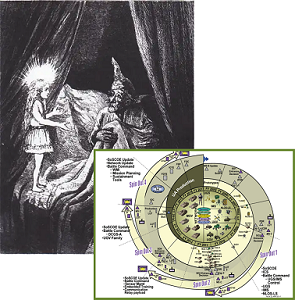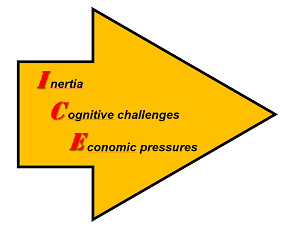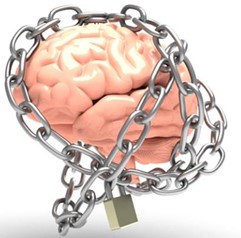[Editor’s Note: Army Mad Scientist is pleased to welcome returning guest blogger Chris Kramer, with an especially salient and timely submission as we continue to glean emergent lessons from 21st Century Large Scale Combat Operations. Although there are pockets of innovation across the U.S. Army, culturally “we actually hire, train, rehearse, plan, resource, promote, acquire, and execute in ways which reinforce regimentation and are the antithesis of rapid adaptability.” Mr. Kramer explores the root causes for this “Circular Failing Squad” and proposes a number of prescriptive fixes, starting with People — a competitive personnel accessions system that ensures the right people enter our ranks and a professional military education system that trains and develops Leaders to be truly adaptive. Read on to learn what else the Army can do to avoid future visits from “the ghosts of modernizations past” — Enjoy!]
 Mark Twain is alleged to have said “History doesn’t repeat itself, but it often rhymes.” Historians, military historians, psychologists, satirists, and futurists from ancient times to today have been painfully aware of this fact of human nature. From the Maginot Line as a specific example of ‘fighting the last war,’ to the endless examples of leaders who rejected whatever “newfangled nonsense” like tanks or airplanes which some smart aleck was trying to introduce to modernize their militaries, truly advancing in military capability often involves overcoming the resistance to change by the ossified dinosaurs — and processes — in one’s own military and nation.
Mark Twain is alleged to have said “History doesn’t repeat itself, but it often rhymes.” Historians, military historians, psychologists, satirists, and futurists from ancient times to today have been painfully aware of this fact of human nature. From the Maginot Line as a specific example of ‘fighting the last war,’ to the endless examples of leaders who rejected whatever “newfangled nonsense” like tanks or airplanes which some smart aleck was trying to introduce to modernize their militaries, truly advancing in military capability often involves overcoming the resistance to change by the ossified dinosaurs — and processes — in one’s own military and nation.
In many minds, military “modernization” means taking an existing platform and making it better. They believe that if we have more advanced versions of the exact same things they had in the last war and which are now sitting on their flight lines and in their motor pools, depreciating in economic and military value at astronomical rates, then “victory will be ours!”


The ghosts of a particular Russian tank battalion, the failures of Task Force Smith, the victims of cognitive and cyber attacks, along with countless others who failed to modernize, or those who lied to themselves and believed they did, say otherwise. The Future Combat Systems experience provided many lessons. Channeling Dickens, we can call these failures “the ghosts of modernizations past.”
In the book Our Inner Ape1, author Frans de Waal recounts a fellow scientist’s experience providing insight into human adaptability. During a trip to Papua New Guinea, the scientist told of two local chiefs about to take their first flight in a small airplane. Not only were they not scared to take the trip, they actually wanted the side door on the airplane to stay open during flight, and for the pilot to fly  over the village of their enemies, so these chiefs could drop heavy rocks on them. The scientist noted he had witnessed “the invention of the bomb by Neolithic man.”
over the village of their enemies, so these chiefs could drop heavy rocks on them. The scientist noted he had witnessed “the invention of the bomb by Neolithic man.”
That is the kind of rapid intuitive integration capability that our national defense enterprise and Nation need. It informs evolutionarily successful strategies which truly adaptive humans, societies, and armies follow. Regardless if they are or appear societally or technologically primitive, properly motivated humans are capable of adapting very quickly to new developments and to new or existing threats, if they have the intellectual and physical capacity to do so, if they try to incorporate the development, and if they are not blocked from doing so. As the New Guinean example above  demonstrates, in mere seconds a quick mind can leverage a totally new development or discovery (airplane), existing technology (rocks) and military thinking (seize and use the high ground) to gain an immediate competitive advantage over an adversary.
demonstrates, in mere seconds a quick mind can leverage a totally new development or discovery (airplane), existing technology (rocks) and military thinking (seize and use the high ground) to gain an immediate competitive advantage over an adversary.
Our military does not do a stellar job of training our Soldiers and Leaders to do this, and proficiency in it degrades in many ways the more rank one achieves. We have made recent although far too painfully-won strides in this area at the tactical level, and our recent Army Modernization Enterprise is a significant advance along some materiel, cognitive, and organizational lines, but the skeletal hands of cognitive, bureaucratic, and fiscal inertia are holding us back, hindering true leap-ahead advancement and (r)evolutionary adaptation.
While we are working to correct our systemic deficiencies, we actually hire, train, rehearse, plan, resource, promote, acquire, and execute in ways which reinforce regimentation and are the antithesis of rapid adaptability. This is a byproduct of several factors:
-
-
-
- The industrial scale on which our military and Nation operate.
- The need to instill discipline, doctrine, and esprit to create a foundationally sound and cohesive force.
- The psychology of large organizations, especially militaries.
- The psychology of those who are attracted to and are promoted to high levels in militaries.
- The failure to follow core principles due to unpleasant factors.
- The overpowering inertia of our members, organizations, and processes.
-
-
 There are three main reasons for the “Circular Failing Squad” so often seen in modernization failures, and they are the same reasons that history (especially military history) repeats so often. They are Inertia, Cognitive challenges, and Economic pressures, or ICE.
There are three main reasons for the “Circular Failing Squad” so often seen in modernization failures, and they are the same reasons that history (especially military history) repeats so often. They are Inertia, Cognitive challenges, and Economic pressures, or ICE.
Inertia. Large and complicated organizations are horrifically difficult to modernize, due to the challenges in updating countless interdependent processes, policies, and practices. Bureaucratic inertia is directly proportional to organization size and the  number of systems it contains. The massive American government and DOD have tremendous inertia. Cognitive inertia is one of the most common byproducts of hubris, which is present in large quantities in the military and many political spheres. Cognitive inertia on the individual, organizational, and societal scales combine to form a circular feedback loop which is extremely hard to overcome.
number of systems it contains. The massive American government and DOD have tremendous inertia. Cognitive inertia is one of the most common byproducts of hubris, which is present in large quantities in the military and many political spheres. Cognitive inertia on the individual, organizational, and societal scales combine to form a circular feedback loop which is extremely hard to overcome.
Cognitive challenges (individual and collective). Human psychology is the true core issue in all human activity, and some especially pernicious issues hinder modernization:
-
-
-
- The inertia mentioned above is largely cognitive, and can be overcome if those who can effect change plan, execute, and carry through the changes.
- The characteristics drilled into military personnel and which make them able to move up the ranks often hamper or prevent modernization. Militaries instill rigidity, compliance, standardization, groupthink, and other conditions which dull or remove innovative thinking.
- Over and above such conditioning, the kind of person who is attracted to the military is often not comfortable with challenging the status quo or authority, or expressing “radical” new thinking.
- Adaptation is often seen at the tactical level, where rapid evolution is necessary to remain alive, and where problem sets are relatively limited. The scope of large-scale evolution diminishes the capacity to intuitively integrate comprehensive modernization models.
- Despite notable exceptions, it may seem counterintuitive that becoming a senior leader in many militaries, at least since the Industrial Revolution, may be an indicator of diminished ability to lead transformation. Having many senior personnel who exhibit the factors mentioned above has always been challenging in militaries trying to modernize, and it always will be, barring major fundamental changes.
- Military modernization decisions are fraught with uncertainty and can have huge penalties for failure. But empirical analyses, Big Data, Red Teaming, and truly independent holistic thinking are available and must be blended with rigorous action to screen out cognitive biases to reach appropriate solutions.
- The list of cognitive biases which hamper individual and group thinking, thus modernization, is quite long, and militaries strongly reinforce many biases. Below is a very short list of military modernization-impactful biases2:
-
-
 Anchoring bias
Anchoring bias
Confirmation bias
Semmelweis reflex
Sunk cost fallacy
Status quo bias
Mere exposure effect
 Cognitive dissonance and denial
Cognitive dissonance and denial
Motivated reasoning
Groupthink
Law of the Instrument

Economic pressures (systemic and individual). In 1961, President Dwight D. Eisenhower warned against the “military-industrial complex.” However, as the top superpower with many adversaries, we need a large industrial base which can support a potential large-scale military need, but we cannot let the tail wag the dog. If our best national security strategy is to make or stop investments which will upend the current applecart, this will impact local and regional economies and draw Congressional attention. Thus DOD’s acquisition decisions must be socialized far enough in advance to enable industry and Congress to prepare for and enable the change. We also must remember Upton Sinclair’s aphorism, “It is difficult to get a man to understand something, when his salary depends on his not understanding it.” Also, as many ‘out of the box’ thinkers in uniform for millennia have known, seen, and experienced, the aphorism of “the tallest blade of grass is the first one cut” is widely present in the DOD, and is the uniformed equivalent of “you ain’t from ‘round here, is ya?”
Wayne Gretzky said his success was due to “going where the puck will be.” That is how the national defense enterprise — with all the associated Diplomatic, Information, Military, Economic, Financial, Intelligence, and Law enforcement instruments of national power (DIMEFIL) — must think and act, if  we are to avoid becoming severely diminished, as did all the other empires in history on whom “the sun never set.” The rate of change of the rate of change in science, technology, and adaptability by our adversaries is increasing. This will be reflected in competition, crisis, and conflict across DIMEFIL. We must adapt faster. Indeed, we must adapt our entire enterprise so that it is capable of rapid adaptation. We must set the conditions for continual evolution and adaptation, just as we engineer our materiel for rapid upgrades.
we are to avoid becoming severely diminished, as did all the other empires in history on whom “the sun never set.” The rate of change of the rate of change in science, technology, and adaptability by our adversaries is increasing. This will be reflected in competition, crisis, and conflict across DIMEFIL. We must adapt faster. Indeed, we must adapt our entire enterprise so that it is capable of rapid adaptation. We must set the conditions for continual evolution and adaptation, just as we engineer our materiel for rapid upgrades.
Today the DOD is typical of a large organization much hampered by hubris and dogmatism. The Army, as the Nation’s primary ground force, must lead the ‘modernizational’ charge to shape our national defense to meet the potential demands of yet another land war in some part of Asia, and the demands of a future force which may not set a single wheel in “a foreign land of which we know nothing” but will fight endless cyber and informational / cognitive wars which are equally as important in ensuring our national security.
The future force requires personnel accessions systems which are more competitive and ensure the right people enter our ranks. We must train and develop leaders to be truly adaptive. Future funding, force design, and acquisition require faster cycles, shorter processes, and may include a model in which substantial segments of the force are well behind others in equipment  age and modernity. We require a model in which substantial effort is engaged in what is and will be permanent and continuous cyber and cognitive fights. Those efforts must inform the rest of the DIMEFIL.
age and modernity. We require a model in which substantial effort is engaged in what is and will be permanent and continuous cyber and cognitive fights. Those efforts must inform the rest of the DIMEFIL.
Even an infinite supply of newer and better guns and tanks will not win the wars of the future, or indeed the wars being waged on us right now. For the Nation to focus only on Materiel solutions is merely to hold a very expensive circular failing squad-EX, and add yet another modernization plan to the dustbin of history. The Army and DOD must collaborate with the rest of government on how to truly fight and win the Nation’s wars in each DIMEFIL element, not just its kinetic military wars, and how and when to wage these wars against the most likely and most dangerous threats. That will be true modernization.
If you enjoyed this post, check out Chris Kramer‘s previous submission S&T Isn’t an Enabler, It’s the Main Effort!
… explore how our adversaries are modernizing in China’s PLA Modernization through the DOTMLPF-P Lens and How will the RUS-UKR Conflict Impact Russia’s Military Modernization? by Dr. Jacob Barton
… and read the following content regarding American innovation and modernization:
Other People’s Wars: The US Military and the Challenge of Learning from Foreign Conflicts and podcast, with Dr. Brent Sterling
The Case for Restructuring the Department of Defense to Fight in the 21st Century, by LTC Christopher J. Heatherly
Are We Ready for the Post-digital Hyper-war? by Capt Martin Crilly, British Army
Delta-V, by Chris Elles
Innovation at the Edge and associated podcast, with senior military leaders, field and company grade officers, and young Soldier/Innovators from the 3rd Infantry Division, 101st Airborne Division, and 18th Airborne Corps
Keeping the Razor’s Edge: 4th PSYOP Group’s Innovation and Evolution Council, by the 4th Psychological Operations Group (4th POG) Innovation and Evolution Council
Strategic Latency Unleashed!, Going on the Offensive in the Fight for the Future, and associated podcast, with former Undersecretary of the Navy (and proclaimed Mad Scientist) James F. “Hondo” Geurts and Dr. Zachary S. Davis
Tactical Innovation: The Missing Piece to Enable Army Futures Command, by LTC Jim Armstrong
The Future of Ground Warfare and associated podcast, with COL Scott Shaw
Innovating Innovation and associated podcast, with Molly Cain
“Once More unto The Breach Dear Friends”: From English Longbows to Azerbaijani Drones, Army Modernization STILL Means More than Materiel and Making the Future More Personal: The Oft-Forgotten Human Driver in Future’s Analysis, by Ian Sullivan
Mission Engineering and Prototype Warfare: Operationalizing Technology Faster to Stay Ahead of the Threat by The Strategic Cohort at the U.S. Army Tank Automotive Research, Development, and Engineering Center (TARDEC).
Four Elements for Future Innovation by Dr. Richard Nabors
The Changing Dynamics of Innovation
Innovation Isn’t Enough: How Creativity Enables Disruptive Strategic Thinking, by Heather Venable
REMINDER: Join Army Mad Scientist and the National Museum of the United States Army (NMUSA) for the Back to the Future: Using History to Forecast conference on 08-09 November 2022, at Fort Belvoir, Virginia. This event will feature world-renowned expert speakers and panelists from  industry, tech, academia, and the U.S. military and other government agencies discussing how history and experience inform and shape our future thinking and decision-making on critical issues. These historians, futurists, and thought leaders will converge backcasting with futurecasting to provide penetrating insights on Army people, materiel, readiness, and doctrine and concepts initiatives. To attend this event in person, register here now!
industry, tech, academia, and the U.S. military and other government agencies discussing how history and experience inform and shape our future thinking and decision-making on critical issues. These historians, futurists, and thought leaders will converge backcasting with futurecasting to provide penetrating insights on Army people, materiel, readiness, and doctrine and concepts initiatives. To attend this event in person, register here now!
About the Author: Chris Kramer is a retired Army engineer officer and futurist working to further the advancement of science, technology, and critical thinking.
Disclaimer: The views expressed in this blog post do not necessarily reflect those of the U.S. Department of Defense, Department of the Army, Army Futures Command (AFC), or Training and Doctrine Command (TRADOC).
1 Web resource at https://www.goodreads.com/book/show/257106.Our_Inner_Ape
2 Web resource at https://en.wikipedia.org/wiki/List_of_cognitive_biases




The following comment was received by Jason
“A very good read. As a hobbyist wargamer, I’ve come across some random souls that were previously officers who are curious about fighting the battles that never happened. I’ve noticed these folks get dismayed as the tactics they learned fail against civilians. A little imagination is a dangerous thing, and it may end up working against us.”